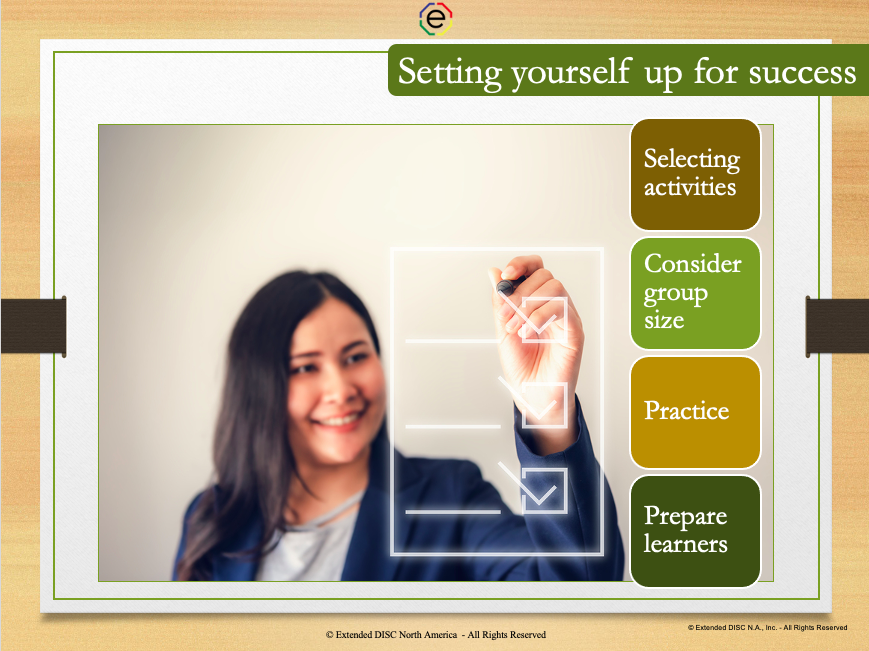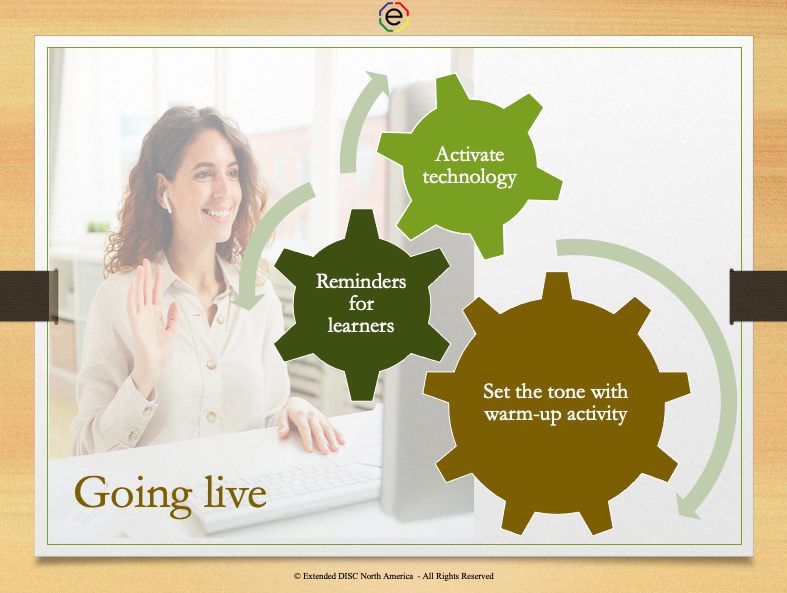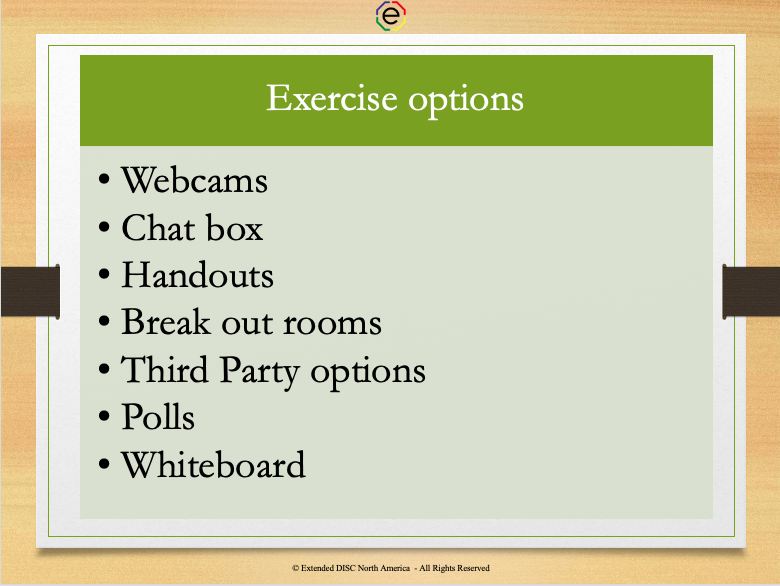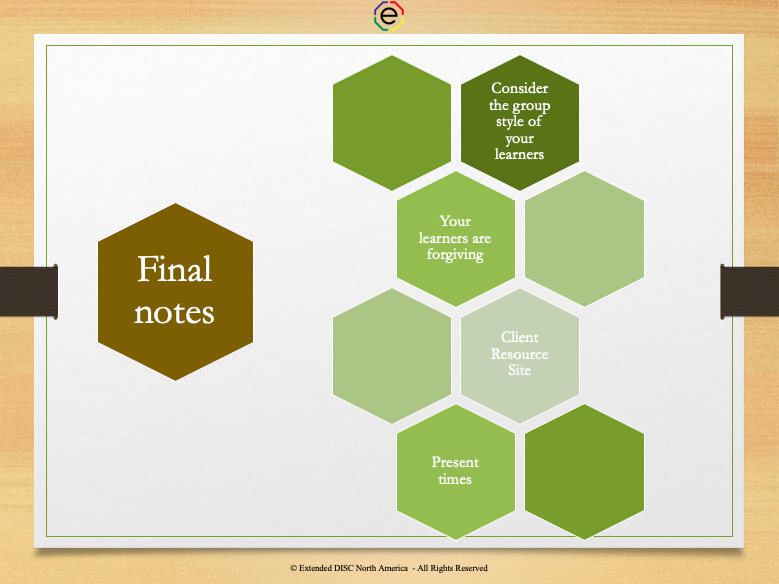Learn tips in using effective activities to make your sessions stand out, while more importantly, helping learners apply DISC tools.
Activities can energize your learners and help them apply DISC in their real-world settings. However, not all exercises are the same and poorly executed ones can diminish the learner’s experience.
Setting yourself up for success: where to start

Take the time to select activities that fit your participant’s learning goals. Do you need brief, energizing activities and/or team-focused ones, requiring more time and breakout rooms? We highly recommend starting off your session with a warm-up activity. It sets an expectation and a positive tone to encourage interactions throughout the rest of your session.
So, where do you start? After identifying the training goals, you may want to consider group size. What activities are inclusive and use everyone’s time wisely, and how does it support session goals? Do you need tech support to better manage larger groups?
Additionally, consider your learners’ styles. Will you have a more reserved group that tend to be listeners and need you to slow down or the opposite? You can gain an advantage by generating an Extended DISC® Name Map to review the potential group’s style.
You don’t need to reinvent the wheel. As an active client, you have access to exercises and activities on the Extended DISC® Client Resource Site.
Setting yourself up for success: practice
Practice the activities prior to the live session. It helps you to determine timing and familiarizes yourself with the logistics, such as game apps and video streaming. The technology may not be familiar for you and also for your learners so know how to manage whiteboards, hand raising, polls, and breakout rooms. You may need to familiarize yourself with a cloud storage service or how to send activities to print out ahead of time. Remember, activities often take longer than you think; people tend to move slower and require more detailed instruction because they are learning the activity for the first time.
It never hurts to have a Plan B because we all have experienced apps not working, the internet connection won’t let you stream, or other tech issues. Your learners tend to be very forgiving; let them know when you are trying something out for the first time or your Wi-Fi has been spotty.
Setting yourself up for success: prepare your learner
Prepare your learners. Do they need their DISC reports or their smartphones? If they need handouts, you can create downloadable links (e.g., Dropbox, Google Docs, etc.). Brief them on technology you will use in the session (e.g., registering, logging on, checking their audio and turning on their webcams) to help manage time and direct focus to the activity. Now, you’re ready to go live!
Going live
 Activitate your technology now that you’re ready to go live! Have your third party apps open (e.g., YouTube, Kahoot, etc.) so you can easily switch between them during the session. As your learners log on, ask them to turn on webcams and check for audio; remind them to test out the mute/unmute button. Can they find the Q&A or Chat, and how to virtually raise their hand? In fact, a good way for them to familiarize themselves with chat is to put a simple greeting question in chat and ask them to respond. For example, “Do you have your DISC report? or “Where are you calling in from?”
Activitate your technology now that you’re ready to go live! Have your third party apps open (e.g., YouTube, Kahoot, etc.) so you can easily switch between them during the session. As your learners log on, ask them to turn on webcams and check for audio; remind them to test out the mute/unmute button. Can they find the Q&A or Chat, and how to virtually raise their hand? In fact, a good way for them to familiarize themselves with chat is to put a simple greeting question in chat and ask them to respond. For example, “Do you have your DISC report? or “Where are you calling in from?”
Don’t forget to provide extra clear instructions when introducing an activity. Your learners may not have the visuals or technical expertise. Once you’ve provided instructions, take a moment to ensure everyone understands them. For example, ask them to virtually raise their hand or indicate in Chat when they are ready. It may be harder to track participation in online sessions so keeping a list may ensure everyone has a chance to contribute.
Consistently check-in with how your learners are engaging and absorbing information, and adapt accordingly. Are they asking a lot of questions? Do you need to pick up the pace? Consider having a few back up activities for when you have extra time or need another option or energy injection. If you do need to slow down or there’s a lot of interaction which is taking up more unplanned time, be prepared to remove an activity. For some of us it’s easy to be flexible, while for others, being prepared with options is the key to success.
Going live: set the tone with welcome warm-up activity
The warm up sets the tone; this is a participatory session!
A simple warm-up activity can be a self-introduction task; ask a simple open-ended question such as, “what experience do you have with DISC” or “where are you from”? You can create a poll asking people “who is the father of DISC?”
Another effective activity is the Mutual Agreement. Think of it as an upfront contract between you and your learners, It helps to set ground rules, expectations and goals and also, helps to build trust in a setting where we are focusing on ourselves. It can help to validate learners’ knowledge they have and can share to learn from one another.
Going live: exercise options

Technology, beyond the virtual meeting itself, is not required to have an engaging session. If all you have access to is the webcam, then use it as a face-to-face opportunity to ask questions and share information and experiences. Use chat for fast interactions and responses to group questions. In fact, you can use chat to create breakout groups by asking people to chat directly with their small group or partner.
Handouts are still practical in virtual sessions as long as you prepare your learners. Send the handouts prior to the session or have them available to download during the session. Do your learners need to print out the handouts? Will they need a writing instrument. Can you use a whiteboard instead of a handout or for chart padding?
Breakout rooms are a good option for larger groups and activities requiring more in depth or specific focus. Even if you are familiar with managing breakout rooms, consider additional tech support if the group is larger.
Third party platforms provide new and exciting online activities (e.g., Kahoot, Quizlet, eQuizShow, etc.), but look for ones that do not require downloading an app or have ads built in. A simpler option could be the polls in your online meeting app. You can create questions ahead of time and run a poll throughout your session. For example, “Which DISC style is more direct and focused more on getting tasks done quickly?” Answer options would be D, I, S, or C.
Regardless of which activity you choose, remember to practice and test it out first. Give plenty of time for instructions, and then have fun!
Post-session: applying the learning
Just as you opened the session with a warm-up activity, it’s also a great idea to close it with a wrap-up one. Consider one that bridges the learning and application to real world experiences. Keep the learning going by offering post-session work because your participants are energized and more motivated to continue the process to success. Once they begin applying the learning, the benefits in improved interactions are often the reinforcement and motivation to keep it going. The Extended DISC Client Resource Site has exercises, guidelines, and Reinforcement Reports to help the learning continue.
If you have the opportunity to conduct follow-ups, try responding in ways that are motivating to your learner’s style. Do they prefer an email or a phone call? Would some benefit by a discussion board they could continue to connect to after the session? Help them practice by asking them to highlight a recent interaction and what they did to modify successfully or what would they do next time? The best reminder is to take a breath between each interaction; it gives the action to a pause. Now, you can reset, consider the style of the other person, and then adjust accordingly.
Final thoughts

Here are just some ideas to enhance your sessions. Consider the group style of your learners when selecting the types of activities. Select the ones that work best for you and your learners. Take your time and do the best you can; your learners understand when we have changed ways of learning and technology glitches.
The end goal of the activities and the sessions are to enhance our ability to interact well with others and support our success.
